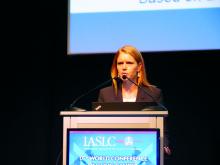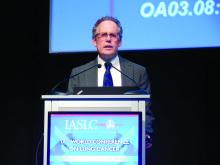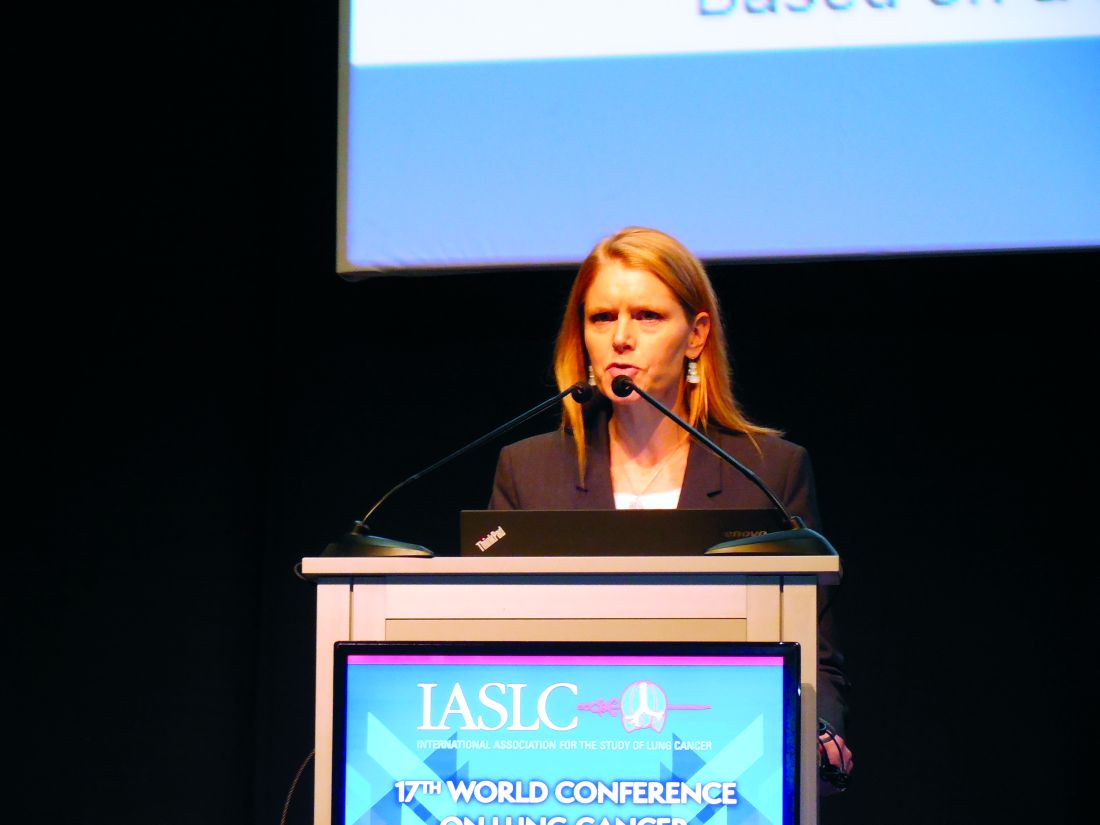User login
VIENNA – The oncologic immunotherapy drug nivolumab works by binding PD-1 receptors, but PD-L1 ligand levels in lung cancers do not predict how responsive patients are to the drug.
“While enhanced clinical activity with nivolumab correlates with increasing tumor PD-L1 expression, nivolumab-treated patients with little or no PD-L1 expression have a comparable probability of response, more durable responses, comparable overall survival, and fewer treatment-related adverse events, compared with patients treated with docetaxel,” Solange Peters, MD, said at the World Conference on Lung Cancer, sponsored by the International Association for the Study of Lung Cancer.
But a more detailed assessment of the survival data by Dr. Peters showed an unexpected pattern of an early hazard among the nivolumab patients. During the first 3 months on randomized treatment, 15 more patients died in the nivolumab arm than in the docetaxel arm. This quickly reversed during months 4-6 on treatment, when nine more patients died on docetaxel than on nivolumab, Dr. Peters reported. By 12 months after the onset of treatment, overall survival was 51% in the nivolumab group and 39% among those randomized to docetaxel.
A post hoc analysis showed a trend to a higher risk for death during the first 3 months of nivolumab treatment among patients with poorer prognostic features, more aggressive disease, and low or no tumor expression of PD-L1, Dr. Peters said.
Although patients with tumors with high levels of PD-L1 expression had the best response rate to nivolumab, patients with no PD-L1 expression had a response to nivolumab that was roughly equivalent to the response to docetaxel among patients randomized to chemotherapy. “Deep and durable responses were seen to nivolumab irrespective of the level of PD-L1 expression,” she said. Among patients with tumors that had a less than 1% rate of PD-L1 expression, the objective response rate was 9% with nivolumab and 15% with docetaxel. Among patients with tumors that had a PD-L1 expression rate of 1% or greater, the objective responses rate was 31% with nivolumab and 12% with docetaxel.
In a landmark analysis that excluded patients who died during the first 3 months on treatment, the pattern of responses to nivolumab and its advantage over docetaxel were similar among patients with no or low PD-L1 expression and among all patients enrolled in the study. In this landmark analysis, the hazard ratio for death after 3 months was reduced with nivolumab treatment by 34% among patients with no or low PD-L1 expression and by 31% in the entire study population, Dr. Peters reported.
CheckMate057 was funded by Bristol-Myers Squibb, the company that markets nivolumab (Opdivo). Dr. Peters has been a consultant to Bristol-Myers Squibb and to several other drug companies.
[email protected]
On Twitter @mitchelzoler
The new analyses reported by Dr. Peters addressed the question of whether patients who receive nivolumab in place of docetaxel are disadvantaged during the first 3 months of treatment. The data showed that in CheckMate057 an excess of 15 patients died in the group randomized to receive nivolumab during the first 3 months on treatment, compared with the control patients treated with docetaxel. This is concerning. Ideally, we’d like to see the patients treated with immunotherapy respond right away, but it takes time for immunotherapy to have an effect.
In almost all immunotherapy studies, a high proportion of patients, often about a third, progress during the first 2-3 months on treatment. It will be important to identify these patients and try new treatment approaches such as combined immunotherapies or a combination of chemotherapy with immunotherapy.
The early excess mortality of 15 patients with nivolumab seen in CheckMate057 must be viewed in context. It represents just 5% of patients randomized to receive nivolumab, and hence this finding should not influence clinical practice. Nivolumab treatment produced a very strong treatment benefit overall during follow-up at 12 and 18 months, compared with docetaxel in this study.
Immunotherapy agents like nivolumab have another advantage, compared with standard chemotherapy drugs, beyond better efficacy in selected patients. Immunotherapy drugs are also generally safer than chemotherapy agents, producing fewer adverse effects. For that reason alone, immunotherapy is preferred as long as its efficacy is comparable to that of chemotherapy. Even in patients with a tumor that does not express PD-L1, and even though some non–small cell lung cancer patients will die early when put on immunotherapy, overall opinion in the clinical community favors a drug like nivolumab over chemotherapy because of its better safety.
Paul Mitchell, MD, is a medical oncologist at the Olivia Newton-John Cancer and Wellness Centre in Heidelberg, Australia. He has served on advisory boards for AstraZeneca, Roche, Boehringer-Ingelheim, BMS, Merck/MSD, Merck Serono, and Celgene; he has received honoraria from Roche and Merck; and he has received travel grants from Roche and BMS. He made these comments as the designated discussant for the report and in an interview.
The new analyses reported by Dr. Peters addressed the question of whether patients who receive nivolumab in place of docetaxel are disadvantaged during the first 3 months of treatment. The data showed that in CheckMate057 an excess of 15 patients died in the group randomized to receive nivolumab during the first 3 months on treatment, compared with the control patients treated with docetaxel. This is concerning. Ideally, we’d like to see the patients treated with immunotherapy respond right away, but it takes time for immunotherapy to have an effect.
In almost all immunotherapy studies, a high proportion of patients, often about a third, progress during the first 2-3 months on treatment. It will be important to identify these patients and try new treatment approaches such as combined immunotherapies or a combination of chemotherapy with immunotherapy.
The early excess mortality of 15 patients with nivolumab seen in CheckMate057 must be viewed in context. It represents just 5% of patients randomized to receive nivolumab, and hence this finding should not influence clinical practice. Nivolumab treatment produced a very strong treatment benefit overall during follow-up at 12 and 18 months, compared with docetaxel in this study.
Immunotherapy agents like nivolumab have another advantage, compared with standard chemotherapy drugs, beyond better efficacy in selected patients. Immunotherapy drugs are also generally safer than chemotherapy agents, producing fewer adverse effects. For that reason alone, immunotherapy is preferred as long as its efficacy is comparable to that of chemotherapy. Even in patients with a tumor that does not express PD-L1, and even though some non–small cell lung cancer patients will die early when put on immunotherapy, overall opinion in the clinical community favors a drug like nivolumab over chemotherapy because of its better safety.
Paul Mitchell, MD, is a medical oncologist at the Olivia Newton-John Cancer and Wellness Centre in Heidelberg, Australia. He has served on advisory boards for AstraZeneca, Roche, Boehringer-Ingelheim, BMS, Merck/MSD, Merck Serono, and Celgene; he has received honoraria from Roche and Merck; and he has received travel grants from Roche and BMS. He made these comments as the designated discussant for the report and in an interview.
The new analyses reported by Dr. Peters addressed the question of whether patients who receive nivolumab in place of docetaxel are disadvantaged during the first 3 months of treatment. The data showed that in CheckMate057 an excess of 15 patients died in the group randomized to receive nivolumab during the first 3 months on treatment, compared with the control patients treated with docetaxel. This is concerning. Ideally, we’d like to see the patients treated with immunotherapy respond right away, but it takes time for immunotherapy to have an effect.
In almost all immunotherapy studies, a high proportion of patients, often about a third, progress during the first 2-3 months on treatment. It will be important to identify these patients and try new treatment approaches such as combined immunotherapies or a combination of chemotherapy with immunotherapy.
The early excess mortality of 15 patients with nivolumab seen in CheckMate057 must be viewed in context. It represents just 5% of patients randomized to receive nivolumab, and hence this finding should not influence clinical practice. Nivolumab treatment produced a very strong treatment benefit overall during follow-up at 12 and 18 months, compared with docetaxel in this study.
Immunotherapy agents like nivolumab have another advantage, compared with standard chemotherapy drugs, beyond better efficacy in selected patients. Immunotherapy drugs are also generally safer than chemotherapy agents, producing fewer adverse effects. For that reason alone, immunotherapy is preferred as long as its efficacy is comparable to that of chemotherapy. Even in patients with a tumor that does not express PD-L1, and even though some non–small cell lung cancer patients will die early when put on immunotherapy, overall opinion in the clinical community favors a drug like nivolumab over chemotherapy because of its better safety.
Paul Mitchell, MD, is a medical oncologist at the Olivia Newton-John Cancer and Wellness Centre in Heidelberg, Australia. He has served on advisory boards for AstraZeneca, Roche, Boehringer-Ingelheim, BMS, Merck/MSD, Merck Serono, and Celgene; he has received honoraria from Roche and Merck; and he has received travel grants from Roche and BMS. He made these comments as the designated discussant for the report and in an interview.
VIENNA – The oncologic immunotherapy drug nivolumab works by binding PD-1 receptors, but PD-L1 ligand levels in lung cancers do not predict how responsive patients are to the drug.
“While enhanced clinical activity with nivolumab correlates with increasing tumor PD-L1 expression, nivolumab-treated patients with little or no PD-L1 expression have a comparable probability of response, more durable responses, comparable overall survival, and fewer treatment-related adverse events, compared with patients treated with docetaxel,” Solange Peters, MD, said at the World Conference on Lung Cancer, sponsored by the International Association for the Study of Lung Cancer.
But a more detailed assessment of the survival data by Dr. Peters showed an unexpected pattern of an early hazard among the nivolumab patients. During the first 3 months on randomized treatment, 15 more patients died in the nivolumab arm than in the docetaxel arm. This quickly reversed during months 4-6 on treatment, when nine more patients died on docetaxel than on nivolumab, Dr. Peters reported. By 12 months after the onset of treatment, overall survival was 51% in the nivolumab group and 39% among those randomized to docetaxel.
A post hoc analysis showed a trend to a higher risk for death during the first 3 months of nivolumab treatment among patients with poorer prognostic features, more aggressive disease, and low or no tumor expression of PD-L1, Dr. Peters said.
Although patients with tumors with high levels of PD-L1 expression had the best response rate to nivolumab, patients with no PD-L1 expression had a response to nivolumab that was roughly equivalent to the response to docetaxel among patients randomized to chemotherapy. “Deep and durable responses were seen to nivolumab irrespective of the level of PD-L1 expression,” she said. Among patients with tumors that had a less than 1% rate of PD-L1 expression, the objective response rate was 9% with nivolumab and 15% with docetaxel. Among patients with tumors that had a PD-L1 expression rate of 1% or greater, the objective responses rate was 31% with nivolumab and 12% with docetaxel.
In a landmark analysis that excluded patients who died during the first 3 months on treatment, the pattern of responses to nivolumab and its advantage over docetaxel were similar among patients with no or low PD-L1 expression and among all patients enrolled in the study. In this landmark analysis, the hazard ratio for death after 3 months was reduced with nivolumab treatment by 34% among patients with no or low PD-L1 expression and by 31% in the entire study population, Dr. Peters reported.
CheckMate057 was funded by Bristol-Myers Squibb, the company that markets nivolumab (Opdivo). Dr. Peters has been a consultant to Bristol-Myers Squibb and to several other drug companies.
[email protected]
On Twitter @mitchelzoler
VIENNA – The oncologic immunotherapy drug nivolumab works by binding PD-1 receptors, but PD-L1 ligand levels in lung cancers do not predict how responsive patients are to the drug.
“While enhanced clinical activity with nivolumab correlates with increasing tumor PD-L1 expression, nivolumab-treated patients with little or no PD-L1 expression have a comparable probability of response, more durable responses, comparable overall survival, and fewer treatment-related adverse events, compared with patients treated with docetaxel,” Solange Peters, MD, said at the World Conference on Lung Cancer, sponsored by the International Association for the Study of Lung Cancer.
But a more detailed assessment of the survival data by Dr. Peters showed an unexpected pattern of an early hazard among the nivolumab patients. During the first 3 months on randomized treatment, 15 more patients died in the nivolumab arm than in the docetaxel arm. This quickly reversed during months 4-6 on treatment, when nine more patients died on docetaxel than on nivolumab, Dr. Peters reported. By 12 months after the onset of treatment, overall survival was 51% in the nivolumab group and 39% among those randomized to docetaxel.
A post hoc analysis showed a trend to a higher risk for death during the first 3 months of nivolumab treatment among patients with poorer prognostic features, more aggressive disease, and low or no tumor expression of PD-L1, Dr. Peters said.
Although patients with tumors with high levels of PD-L1 expression had the best response rate to nivolumab, patients with no PD-L1 expression had a response to nivolumab that was roughly equivalent to the response to docetaxel among patients randomized to chemotherapy. “Deep and durable responses were seen to nivolumab irrespective of the level of PD-L1 expression,” she said. Among patients with tumors that had a less than 1% rate of PD-L1 expression, the objective response rate was 9% with nivolumab and 15% with docetaxel. Among patients with tumors that had a PD-L1 expression rate of 1% or greater, the objective responses rate was 31% with nivolumab and 12% with docetaxel.
In a landmark analysis that excluded patients who died during the first 3 months on treatment, the pattern of responses to nivolumab and its advantage over docetaxel were similar among patients with no or low PD-L1 expression and among all patients enrolled in the study. In this landmark analysis, the hazard ratio for death after 3 months was reduced with nivolumab treatment by 34% among patients with no or low PD-L1 expression and by 31% in the entire study population, Dr. Peters reported.
CheckMate057 was funded by Bristol-Myers Squibb, the company that markets nivolumab (Opdivo). Dr. Peters has been a consultant to Bristol-Myers Squibb and to several other drug companies.
[email protected]
On Twitter @mitchelzoler
AT WCLC 2016
Key clinical point:
Major finding: When tumors had at least 1% PD-L1 expression, objective response rates were 31% with nivolumab and 12% with docetaxel.
Data source: CheckMate057, a pivotal trial of nivolumab that enrolled 592 patients with advanced, nonsquamous non–small cell lung cancer.
Disclosures: CheckMate057 was funded by Bristol-Myers Squibb, the company that markets nivolumab (Opdivo). Dr. Peters has been a consultant to Bristol-Myers Squibb and to several other drug companies.


